

 |
Search the Site with

|
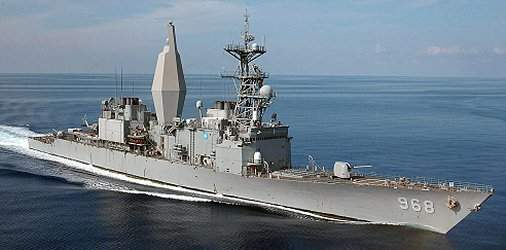 | 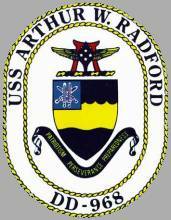 |
USS ARTHUR W. RADFORD was the eighth ship in the SPRUANCE - class and the Navy’s test platform for the AEM/S System.
After being decommissioned, ARTHUR W. RADFORD was towed to the Naval Sea Systems Command (NAVSEA) Inactive Ships Maintenance Office in Philadelphia. Later, the ship was scheduled to be towed to Pascagoula, Miss., where Northrop Grumman was to equip it with the new DD(X) technology. Some of this technology included three engineering development models comprised of an integrated power system, composite deckhouse and dual band radar. The integrated power system would allow rapid reconfiguration of power, reduced acoustic noise, and greater flexibility in ship design.
The conversion was scheduled to begin in fall of 2004 and would have taken approximately one year. However, ARTHUR W. RADFORD's DD(X) conversion was cancelled and the destroyer was subsequently laid-up in Philadelphia awaiting final disposal. Initially, the sinking was planned for mid-2010, however, the date was later delayed to November 2010, but that date couldn't be met as well. Susequent sinking plans for spring 2011 were also cancelled and the actual sinking of the destroyer took place on August 10, 2011, off Cape May.
Commissioned in 1977, ARTHUR W. RADFORD has completed 10 deployments where it participated in many exercises and missions, such as Exercise Multiplex-79, Exercise Dawn Patrol and Operation Enduring Freedom. During the ship’s service, it had been to Venezuela, Panama, Argentina, Brazil, Senegal, Oman, Bahrain, the Azores, Nova Scotia, Italy and Turkey.
USS RADFORD was homeported in Norfolk, Va.
| General Characteristics: | Awarded: January 15, 1971 |
| Keel laid: January 24, 1974 | |
| Launched: March 1, 1975 | |
| Commissioned: April 16, 1977 | |
| Decommissioned: March 18, 2003 | |
| Builder: Ingalls Shipbuilding, West Bank, Pascagoula, Miss. | |
| Propulsion system: four General Electric LM 2500 gas turbine engines | |
| Propellers: two | |
| Blades on each Propeller: five | |
| Length: 564,3 feet (172 meters) | |
| Beam: 55,1 feet (16.8 meters) | |
| Draft: 28,9 feet (8.8 meters) | |
| Displacement: approx. 9,200 tons full load | |
| Speed: 30+ knots | |
| Aircraft: two | |
| Armament: two | |
| Crew: approx. 340 |
Crew List:
This section contains the names of sailors who served aboard USS ARTHUR W. RADFORD. It is no official listing but contains the names of sailors who submitted their information.
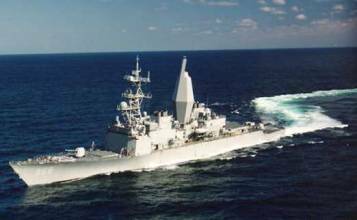
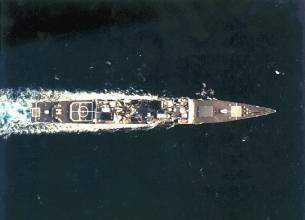
USS ARTHUR W. RADFORD Cruise Books:
About the Ship’s Name, about Admiral Arthur W. Radford:
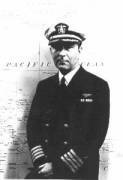 Admiral Radford served in three wars. He was onboard the USS SOUTH CAROLINA, a battleship in the Atlantic Fleet, and was Aide and First Lieutenant to commander, Battleship Division ONE during World War I. He served in the Navy Department's Bureau of Aeronautics and Naval Personnel and in the Office of the Chief of Naval Operations early in World War II; and as Commander, Carrier Divisions 11 and 6, and on the Staff of Commander, Aircraft Pacific, during the after part of that war. At the outbreak of Korean hostilities, he was serving as commander in Chief, U. S. Pacific Fleet, later being given the responsibility of the Marianas Bonin area and the Philippines Formosa area.
Admiral Radford served in three wars. He was onboard the USS SOUTH CAROLINA, a battleship in the Atlantic Fleet, and was Aide and First Lieutenant to commander, Battleship Division ONE during World War I. He served in the Navy Department's Bureau of Aeronautics and Naval Personnel and in the Office of the Chief of Naval Operations early in World War II; and as Commander, Carrier Divisions 11 and 6, and on the Staff of Commander, Aircraft Pacific, during the after part of that war. At the outbreak of Korean hostilities, he was serving as commander in Chief, U. S. Pacific Fleet, later being given the responsibility of the Marianas Bonin area and the Philippines Formosa area.
Born in Chicago, Illinois, in February 1896, he entered the Naval Academy in 1912 after graduating from High School in Grinnel, Iowa. He graduated and was commissioned in 1916 and assigned to USS SOUTH CAROLINA. From the end of World War I until 1920 he served staff duty. In April 1920 he was assigned to flight training school and was designated a Naval Aviator in November of that year. Follow on assignments included the newly established Bureau of Aeronautics, Navy Department, as well as the aviation units of the tender AROOSTOCK, and the battleships COLORADO and PENNSYLVANIA.
In December 1945, he became Deputy Commander of Naval Operations (Air) and after a year in command of SECOND TASK FLEET, he returned to the Navy department as Vice Chief of Naval Operations. In June 1953 he was appointed Chairman of the Joint Chiefs of Staff. He retired on 1 August 1957.
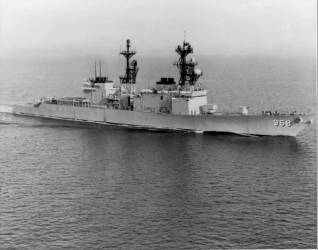
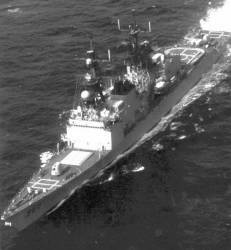
About the Advanced Enclosed Mast Sensor (AEM/S) System:
 The U.S. Navy's first-ever advanced hybrid composite structure, known as the Advanced Enclosed Mast/Sensor (AEM/S) System, has been installed aboard the SPRUANCE Class multimission destroyer USS ARTHUR W. RADFORD , at Norfolk Naval Shipyard, Portsmouth, Virginia. Since FY 1998, the ship is the platform for extensive testing of the new mast by the Navy.
The U.S. Navy's first-ever advanced hybrid composite structure, known as the Advanced Enclosed Mast/Sensor (AEM/S) System, has been installed aboard the SPRUANCE Class multimission destroyer USS ARTHUR W. RADFORD , at Norfolk Naval Shipyard, Portsmouth, Virginia. Since FY 1998, the ship is the platform for extensive testing of the new mast by the Navy.
The new, advanced composite mast, which the Navy describes as "revolutionary and spectacular," was built and designed by an Integrated Product Team (IPT) -- known as "The AE MIS System Masters" -- made up of technical experts drawn from diverse Navy and industry activities nationwide.
The AEM/S System is a 93' high, hexagonal structure, 35' in diameter, enclosing existing radar and providing important signature and other operational benefits. By enclosing major antennas and other sensitive equipment, the AEM/S System protects them from the weather. This reduces maintenance, as well as providing significantly reduced radar signature.
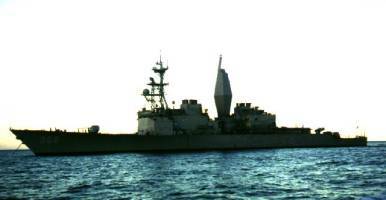 A traditional "Mast Stepping" Ceremony was held on 17 May at Norfolk Naval Shipyard to commemorate mast installation and to honor the AEM/S System Masters who dedicated more than three years to the project.
A traditional "Mast Stepping" Ceremony was held on 17 May at Norfolk Naval Shipyard to commemorate mast installation and to honor the AEM/S System Masters who dedicated more than three years to the project.
The AEM/S System ATD has developed a revolutionary mast that is affordable, solves problems associated with current masts, enables new technology required for the Navy's next generation of stealthy ships, reduces life-cycle costs, enhances sustainability, and most importantly, enhances war-fighting capabilities. Successful completion of this ATD is a key element in the incorporation of advanced technology into the topside design for the next generation of surface combatants.
The AEM/S System is a high-risk, high-payoff Advanced Technology Demonstration. Benefits and payoffs include:
Enhanced Performance:
The AEM/S System is fabricated with an advanced composite hybrid frequency selective surface (FSS), designed to allow passage of own-ship sensor frequencies while reflecting other frequencies. Improved sensor performance results from reduction of blockage, false targets and sensor downtime, thereby dramatically enhancing the ship's war-fighting capability.
Affordable Low-Cost Manufacturing:
The AEM/S System utilizes unique materials, creative structures and innovative manufacturing techniques, yet the mast can be produced in a shipyard environment.
Affordable Reduced Life-Cycle Costs:
The AEM/S System's enclosed structure protects radar and communication antennas from weather exposure and provides all-weather access for repair, thus greatly reducing the need for repair, maintenance costs, replacement costs and risk of failure.
Enhanced sustainability:
The AEM/S System concept will enable rapid and seamless transition to the next generation of technology. Features such as embedded sensors, planar arrays, integrated antennas, low observable signatures, reduced topside weight -- all contribute to the Navy's objectives for future warships. Accelerated transition of AEM/S System technology to the LPD 17 is already underway, along with evaluation of its applicability to the SC 21 and CV(X).
The upper half of the AEM/S System is designed to allow passage of own-ship sensor frequencies with very low loss while reflecting other frequencies. It is divided into two radome-like compartments; the upper compartment houses the MK 23 TAS antenna, and the lower encloses the SPSAO air search radar antenna.
The whole system is a free-standing, fully integrated composite structure. Structural design requirements for strength and stiffness meet Fleet requirements for vibration, shock and fatigue. Signature and electromagnetic design requirements are based on criteria associated with sensor and antenna performance, electromagnetic interference, lighting protection electromagnetic shielding, electrical bonding and grounding.
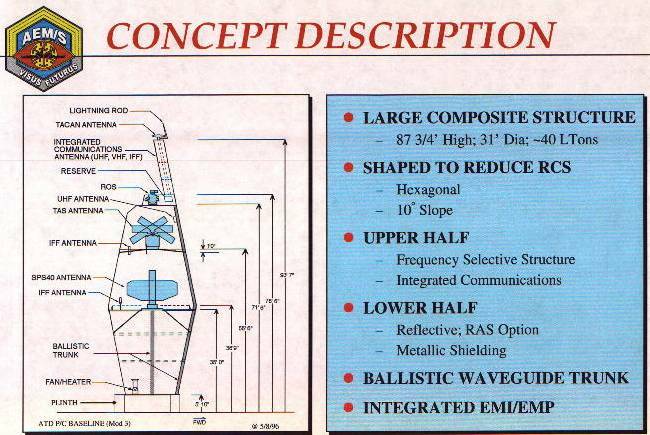
Accidents aboard USS ARTHUR W. RADFORD:
| Date | Where | Events |
|---|---|---|
| February 4, 1999 | 25 miles northeast off Virginia Beach |
At about 11:30 p.m. the RADFORD collided with the SAUDI RIYADH, a 29,259-ton, 656-foot-long, roll-on, roll-off container ship, which was preparing to enter the Chesapeake Bay for Baltimore. According to the Navy, the RADFORD was conducting calibration tests on electronics equipment at the time of the collision. The tests required the ship to operate in circles around an electronic buoy. The SAUDI RIYADH, meanwhile, was approaching the Chesapeake Bay from the northeast, preparing to line up in the shipping lanes before taking on a marine pilot for its eventual trip to Baltimore. When they collided, the Saudi ship's bow struck the starboard side of the RADFORD, about 30 feet behind its bow. A pie-shaped gash, penetrating into the centerline of the RADFORD, left a hole from the deck to the waterline, toppled its 5-inch 54-caliber gun and damaged Tomahawk cruise missile tubes. The SAUDI RIYADH sustained a four-foot-high, 30-foot-long gash along the port and starboard sides of its bow, with most of the damage to its port side. The RADFORD, more heavily damaged, sustained a deep gash on its starboard side, penetrating nearly 25 feet into the main deck, ripping a hole from the deck to below the waterline. One sailor aboard suffered a broken arm. The RADFORD sustained an estimated $32.7 million in damages and the damage prevented the RADFORD from leaving March 26 on a scheduled six-month deployment to the Mediterranean Sea with the carrier THEODORE ROOSEVELT battle group. Repairs aboard the RADFORD were completed on September 13 and the destroyer then deployed with the EISENHOWER battle group. As a result of the collision, RADFORD's commanding officer was relieved. 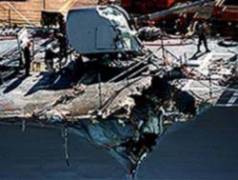 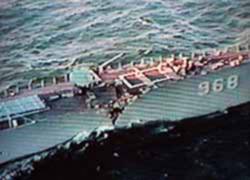 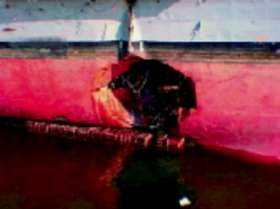 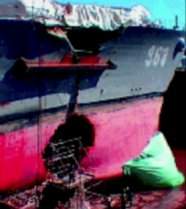 |
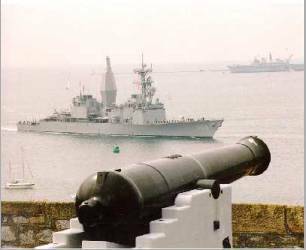
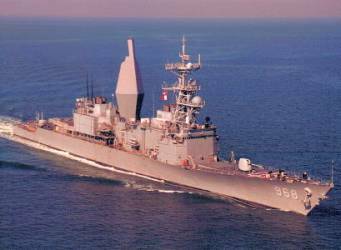
About the Ship’s Coat of Arms: The ship's crest is highly symbolic of the ship's namesake, Admiral Arthur W. Radford, and his uncompromising devotion to the defense of our country.
The ship's crest is highly symbolic of the ship's namesake, Admiral Arthur W. Radford, and his uncompromising devotion to the defense of our country.
The gold wings represent Admiral Radford's own wings which he earned in 1920. Together with the ship's bow these wings allude to his command of Carrier Divisions 11 and 6, Pacific, during World War II. The four white stars symbolize his promotion to Admiral, while the Red Torii represents his involvement in both World War II and the Korean War.
Three divisions of the shield itself refer to the three components of the armed forces; Air, Sea, and Land, which each form a portion of our nation's protective shield. The four unsheathed swords on the Defense Blue background symbolize his appointment to the head of the Joint Chiefs of Staff, and his re-appointment to this position for a second term.
Admiral Radford's career was dominated by three traits which are displayed on the Navy Blue banner beneath the shield: Patriotism, Perseverance, and Preparedness.
History of USS ARTHUR W. RADFORD:
ARTHUR W. RADFORD was laid down on 31 January 1974 at Pascagoula, Miss., by the Ingalls Shipbuilding Division of Litton Industries; launched on 27 February 1975; sponsored by Mrs. Arthur W. Radford, the widow of the late admiral, placed in "special service" on 4 April 1977 upon delivery to the Navy, Comdr. David E. Woodbury in command, and commissioned at her builder's yard on 16 April 1977.
Underway for the east coast that same day, ARTHUR W. RADFORD was forced to return to her builder's yard for repairs soon thereafter, but got underway again on 30 April. Touching at Charleston on 3 and 4 May, the ship proceeded to her home port Norfolk, which she reached on the 6th.
Three days later, she sailed for Newport, to provide support for the Naval Surface Warfare Of Officer Training Command. While the ship proceeded north, a LAMPS helicopter landed on her helo deck to prepare for the possible embarkation of a LAMPS detachment. The helicopter returned to Norfolk later that day 11 May. Mooring at Newport on 13 May, the destroyer remained there until the 17th, when she headed home. Soon after returning to Norfolk, she conducted gunnery exercises and helicopter operations off the Virginia capes.
The ship headed down the coast on 24 May and reached Port Canaveral, Fla., the following day. After embarking Capt. R. K. Albright, Commander, Destroyer Squadron 22 the destroyer got underway on the 27th and, for the next few days, conducted air, surface, and sub-surface surveillance of the surrounding waters while the President of the United States, Jimmy Carter, observed operations on board the attack submarine LOS ANGELES (SSN 688). The destroyer rendezvoused with the submarine prior to her initial dive and then again when the submarine surfaced. Throughout the operation, she provided support services for local and national press covering the Chief Executive's voyage.
Underway for Norfolk on 31 May, ARTHUR W. RADFORD reached her home port on 2 June for local operations. While returning from waters off the Virginia capes on 6 June, the ship ran into low-visibility conditions and winds in excess of 90 knots which disabled a radar antenna and literally drove the ship outside of the main shipping channel. At one point her fathometer read only one foot of water under the keel.
Fighting her way back to the channel in the teeth of the gale ARTHUR W. RADFORD sighted a capsized motor vessel, DIXIE LEE II, 300 yards south of Thimble A Shoals Channel bouy 21. Unable to assist due to the shallow water and high winds, the destroyer notified the Coast Guard of bodies seen floating in the water. The destroyer then anchored in Hampton Roads until the wind had dropped and shipping, adrift in the vicinity, had moved off.
ARTHUR W. RADFORD then proceeded to the West Indies for training operations including gunfire support. En route to Frederickstad, St. Croix, in the American Virgin Islands, in late June she conducted further weapons tests. Firing a gunnery exercise at Vieques, Puerto Rico, the destroyer returned to the eastern seaboard with a port visit to Fort Lauderdale, Fla., on Independence Day 1977. Further work in the Bahamas, and at Guantanamo Bay, preceded her return to Charleston, S.C., on the last day of July. She then headed home where she arrived on 3 August.
The ship returned to Pascagoula on 11 September for post shakedown availability and remained in her builder's hands until she returned to Norfolk in mid-October. Entering the Norfolk Naval Shipyard on 25 October for restricted availability, she remained there into the spring of 1978 before resuming local operations out of her home port. She principally engaged in ship Qualification trials and underway training before sailing south to Guantanamo Bay and Vieques for refresher training and gunfire support practice, respectively. Following these evolutions the ship returned to Norfolk on 30 July 1978.
On 23 August, ARTHUR W. RADFORD got underway from the Naval Weapons Station, Yorktown, Va., and headed for NATO exercises in the North Atlantic. En route, she participated in Exercise "Common Effort," carrying out escort duties in an "opposed Atlantic transit," and briefly embarked Vice Admiral Wesley L. McDonald, Commander, 2nd Fleet. Next came Operation "Northern Wedding"a joint NATO exercise which began on 4 September and involved several carrier groups in an amphibious landing and many other facets of simulated naval warfare. During that operation, ARTHUR W. RADFORD operated alongside British, Danish, Norwegian, Swedish, West German, and Canadian naval units.
Following the conclusion of "Northern Wedding," the destroyer visited Copenhagen, Denmark; Rotterdam, Holland, and Portsmouth, England. She again embarked Vice Admiral McDonald at Portsmouth on 16 October and wore his flag during the return voyage to Norfolk. The admiral disembarked upon her arrival at Norfolk on 25 October. The warship then operated locally through the winter, varying periods in port of upkeep with underway training.
ARTHUR W. RADFORD cleared Norfolk on 13 March 1979, bound for the Mediterranean and a tour with the 6th Fleet. Over the next six months, she participated in a variety of exercises and visited the ports of Catania, Sicily, Split, Yugoslavia; Trieste Italy; Alexandria, Egypt; Cannes, France, Palma and Barcelona Spain; the French ports of Toulon and Theoule, and the Spanish ports of Rota and Valencia. During the deployment, the vessel fired her first Harpoon missile in the Mediterranean on 28 July. Her target was the hulk of a destroyer, ex- LANSDOWNE (DD 486) (later the Turkish GAZIANTEP, D 344). ARTHUR W. RADFORD also participated in Exercise "Multiplex 1-79" in the Ionian Sea, Exercise "Dawn Patrol" in the Tyrrhenian and Ionian Seas, Exercise "Tridente" out of Alexandria, and Exercise "National Week" XXVII, Phases 1 and 2. While en route from Toulon to Theoule, France, she rescued the French ketch, LAURCA, adrift 50 miles from the French resort of St. Tropez.
Clearing Rota on 12 September, ARTHUR W. RADFORD reached Norfolk on the 22nd. Underway for Miami on 23 October, she served as the platform for deck landing qualifications for helicopter pilots en route, and, after touching at Mayport, Fla., to unload a crippled H-3 helicopter from HSL-30, reached Miami on 27 October for a two-day port visit.
After returning briefly to Norfolk from 31 October to 5 November, the destroyer proceeded to Halifax, Nova Scotia and participated in a training exercise with American and Canadian warships. During the course of Exercise "Canus-Marcot" she logged her 1,000th helicopter landing of 1979. Returning to Norfolk on 21 November, she remained in port for the remainder of the year 1979.
For the first half of 1980, the warship principally operated off the eastern seaboard of the United States, and ranged as far north as Halifax and as far south as the Caribbean, working briefly out of Vieques and Roosevelt Roads, as well as out of Jacksonville, Fla. During this time, she also visited Annapolis, where Naval Academy midshipmen toured the ship's engineering plant on an orientation visit. Admiral James L. Holloway III, the former Chief of Naval Operations, visited the ship as well.
Following a brief period at the Norfolk Naval Shipyard, ARTHUR W. RADFORD prepared for another extended deployment. She departed Norfolk on 21 June, embarking HSL-34, Detachment 2 and proceeded to Roosevelt Roads, where she embarked Rear Admiral Peter K. Cullins, Commander, South Atlantic Force and his staff to become Cullins' flagship for UNITAS XXI. Visits to St. Kitts and to Bridgetown, Barbados, followed before the destroyer sailed for Venezuelan waters.
Over the next four months, ARTHUR W. RADFORD operated with elements of the Venezuelan, Ecuadorian, Peruvian, Colombian Trinidad and Tobagan, Argentine, Uruguayan, and Brazilian Navies. Her ports of call included Puerto La Cruz and La Guaira Venezuela, Rodman, Panama, Manta, Ecuador, Paito and Callao Peru, Cartagena, Colombia; Trinidad and Tobago, Santos, Brazil Puerto Belgrano, and Bahia Blanca, Argentina, Montevideo Uruguay, and the Brazilian ports of Rio de Janeiro, Salvador and Recife. She also transited the Panama Canal twice during UNITAS XXI, the first time on 21 July 1980 and the second on 24 August.
Completing UNITAS XXI on 4 November, ARTHUR W. RADFORD sailed for Gabon, as a unit of the West Africa Training Cruise (WATC), reaching Libreville, the capital of Gabon, on 12 November. Over the next few weeks, she visited Tema, Ghana Freetown, Sierra Leone, and Dakar, Senegal. Clearing Dakar on 1 December, the destroyer stopped at Guadalupe and at Roosevelt Roads on the return voyage and arrived at Norfolk on 15 December.
The ship spent the next two years engaged in operations along the east coast and in the West Indies mostly in underway training out of Norfolk, Roosevelt Roads, and Vieques and in refresher training at Guantanamo Bay. During the summer of 1981, she operated out of Annapolis, training midshipmen. She underwent upkeep at Norfolk and Boston and received an overhaul at her builder's yard. En route to Puerto Rico, the ship had a Coast Guard detachment embarked from 20 to 23 September 1982, and cooperated with the Coast Guard on drug interdiction duties.
For the first few months of 1983, ARTHUR W. RADFORD operated primarily in the Virginia capes area, but ranged into the Atlantic as far as the Bahamas. After embarking Commander, Destroyer Squadron 26, at Norfolk on 7 March to begin a nine-month period on board, ARTHUR W. RADFORD hosted Secretary of the Navy John F. Lehman, Jr., on 29 March. A little less than one month later the destroyer cleared Norfolk on 27 April for a six-month deployment in the Mediterranean.
Touching at Gibraltar on 10 May, ARTHUR W. RADFORD proceeded to Augusta Bay, Sicily, and thence moved to waters off the coast of Lebanon. After supporting the multinational peacekeeping force in Beirut from 20 to 28 May, the destroyer visited Taranto, Italy, before returning to Lebanese waters for another brief period. During a port call at the Romanian port of Constanta along with guided-missile frigate ANTRIM (FFG 20), the destroyer served as flagship for Vice Admiral William H. Rowden, Commander, 6th Fleet.
Visiting Catania, Sicily, Monte Carlo, Monaco, and Livorno Italy, ARTHUR W. RADFORD exercised with 6th Fleet battle groups later that summer, later visiting Gaeta and Naples, Italy. While visiting Istanbul, Turkey, she hosted the retired Army leader and former Presidential advisor General Alexander M. Haig.
ARTHUR W. RADFORD returned to the waters off Beirut on 18 September 1983 to assume duty as ready gunfire support ship. She conducted gunfire support missions against forces threatening the peacekeeping force on 21 and 22 September until relieved on station by the battleship NEW JERSEY (BB 62) on 8 October. Visits to La Maddalena, Sardinia, and to Tangier, Morocco rounded out the destroyer's time in the 6th Fleet. Operating briefly with Spanish Navy units en route to the turnover port of Rota, ARTHUR W. RADFORD cleared Rota on 10 November with the battle group formed around the carrier DWIGHT D. EISENHOWER (CVN 69). She arrived at Norfolk 11 days later, remaining there for the rest of 1983.
ARTHUR W. RADFORD operated briefly in the Virginia capes area in January 1984 before undergoing an overhaul at the Metro Machine Shipyard at Portsmouth, Va., between 16 February and 27 April. Subsequently undergoing sea trials and repairs in the floating drydock SUSTAIN (AFDM 7), ARTHUR W. RADFORD conducted routine training out of Norfolk through early August.
The destroyer next operated out of Roosevelt Roads and off St. Croix before returning to Norfolk at the end of August and becoming flagship for Destroyer Squadron 10. After then conducting underway training in the Virginia capes area in September and October, ARTHUR W. RADFORD accompanied the recommissioned battleship IOWA (BB 61) to Roosevelt Roads. She later conducted gunfire support exercises off Vieques. Returning northward the destroyer took part in exercises off the coast of North Carolina before reaching to Norfolk on 20 November.
After local operations, Arthur W. Radford sailed for a deployment with the Middle East Force (MidEastFor) on 4 February 1985, in company with BARNEY (DDG 6). Rendezvousing with ANTRIM and CHARLES F. ADAMS (DDG 2) near Bermuda two days later, and refueling from USNS WACCAMAW (T-AO 109), the destroyer reached Rota on 16 February. She then visited Naples before heading for Egypt to transit the Suez Canal on 27 February 1985.
The destroyer touched briefly at Mina Raysut, Oman, on 8 March before transiting the Strait of Hormuz the following day and entering the Persian Gulf After touching briefly at Bahrain ARTHUR W. RADFORD got underway on the 14th for the Persian Gulf radar picket station (RPS). Five days into her time on station, she responded to a "Mayday" from the Liberian-flag tanker Caribbean Breeze which had been attacked and set afire in the central Persian Gulf. The destroyer provided medical advice over the emergency radio channel and launched a helicopter to render assistance.
Refueling on 25 March at Sitrah Anchorage, Bahrain, ARTHUR W. RADFORD got underway to resume her radar picket duty later the same day, remaining employed thus until she moored alongside LA SALLE (AGF 3) for availability. The destroyer resumed steaming on radar picket station again on 8 April, also conducting surveillance operations simultaneously.
ARTHUR W. RADFORD embarked Rear Admiral John Addams ComMidEastFor, on 17 April, and served as his flagship until 5 June. During that time, the destroyer served twice on radar picket duties in the Persian Gulf, the first from 17 to 26 April and the second from 23 to 29 June, and once on routine cruising. She visited the Sitrah anchorage twice during this period, and visited Manama, Bahrain, twice.
After Rear Admiral Addams shifted his flag from ARTHUR W. RADFORD, the ship served two more tours of radar picket duty in the Persian Gulf (6 to 16 June and 20 to 29 June). During the first of these periods, on 7 June, the destroyer's embarked Sikorsky SH-3 "Sea King" helicopter from squadron HS-1 transported a civilian rescued from drowning and in need of medical attention to Bahrain hospital, saving the person's life.
ARTHUR W. RADFORD underwent her final upkeep in the Persian Gulf at Mina Sulman, Manama, Bahrain, from 29 June to 4 July observing Independence Day there before getting underway that afternoon to transit the Persian Gulf for the Strait of Hormuz. She conducted turnover to the destroyer COMTE DE GRASSE (DD 974) the following day, and exited from the gulf.
Stopping for fuel at Mina Raysut, Oman, on 8 July, ARTHUR W. RADFORD transited the Strait of Bab el Mandeb in company with ANTRIM on 10 July, and the two warships conducted freedom of navigation operations off the coast of the Democratic People's Republic of Yemen on the 11th. The destroyer transited the Suez Canal on the 14th, and replenished from the oiler USNS NEOSHO (T-AO 143) that same day. Fueling from USNS TRUCKEE (T-AO 148) the following day, ARTHUR W. RADFORD conducted a port visit to Benidorm, Spain, from 20 to 23 July before reaching Rota on the 24th. Proceeding thence with ANTRIM, BARNEY, and CHARLES F. ADAMS, the destroyer sailed for Norfolk on 24 July. After visiting Ponta Delgada, in the Azores, and Bermuda, en route, ARTHUR W. RADFORD reached her home port on 5 August 1985.
The destroyer remained at Norfolk into late October, preparing for a command inspection and operating locally in the Virginia capes operating area. Early in this period, Hurricane "Gloria" prompted ARTHUR W. RADFORD to depart Norfolk on 13 September 1985, and proceed to the upper Chesapeake Bay anchorage to ride out the storm. The destroyer returned to her home port on 21 September.
Departing Norfolk on 25 October, ARTHUR W. RADFORD sailed for Nova Scotia, and arrived at Halifax on the 28th. After being briefed for her participation in an exercise, SHAREM 62, the ship departed Halifax on the following day for Notre Dame Bay Newfoundland. Transiting the Strait of Belle Isle on the 31st ARTHUR W. RADFORD reached her destination on 1 November, and took part in SHAREM 62 until the 6th, when she sailed for Halifax.
Following the post-exercise debriefing, ARTHUR W. RADFORD sailed for Norfolk, arriving at her home port on 13 November. Moving up the eastern seaboard, the destroyer visited Boston (5 to 8 December) before spending a brief Period at Newport serving as Surface Warfare Officer School (SWOS) school ship from 9 to 12 December. ARTHUR W. RADFORD then returned to the Norfolk area, unloading weapons at Yorktown from 15 to 18 December before conducting a dependents' cruise on the 18th.
The destroyer underwent a restricted availability until late March 1986, running her post-repair trials on 29 and 30 March before Proceeding to Yorktown to take on weapons. ARTHUR W. RADFORD operated locally out of Norfolk into late July, interspersing this work with a drydocking in SUSTAIN from 30 May to 17 June, for repairs to her struts and stern tubes, as well as an inspection of her sonar dome. Following refresher training in Guantanamo Bay, the ship touched at Roosevelt Roads before operating at Vieques for gunfire support practice, surface gunnery exercises, and missile shoots. After visiting Fort Lauderdale en route, the ship returned to Norfolk on 12 September.
ARTHUR W. RADFORD returned to Guantanamo Bay soon thereafter to embark HSL-36, detachment 6, and then proceeded to Roosevelt Roads, where she arrived on 6 October to load ammunition, to take on fuel, and to embark a Coast Guard law enforcement detachment along with Commander, Caribbean Squadron (ComCaribRon) and his staff. The ship operated in her assigned waters from 6 to 19 October, returning to Roosevelt Roads to debark ComCaribRon and his staff.
Detaching the Coast Guardsmen at Nassau on 22 October at the commencement of the ship's port visit there, ARTHUR W. RADFORD sailed for Norfolk on the 25th, arriving two days later. As before, her stay in port proved brief, for she got underway on 3 November for the Bermuda operating area for exercises. One day out of Norfolk, she assisted PREBLE (DDG 46) in searching for a crewman who had been lost in the Cape Hatteras area.
ARTHUR W. RADFORD conducted her exercises, SHAREM 1-87 before returning to Norfolk on 16 November. With the exception of a period underway in the Virginia capes operating area on 9 and 10 December, ARTHUR W. RADFORD spent the month of December in port Norfolk.
USS ARTHUR W. RADFORD Image Gallery:
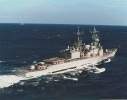 | 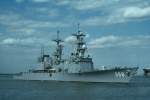 |  | 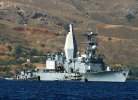 | 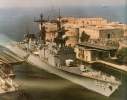 |
The photos below were taken by Brian Barton and show ARTHUR W. RADFORD at Naval Base Norfolk, Va., on July 23, 2002. The destroyer departed on its 2002 deployment the same day.
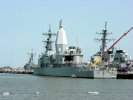 | 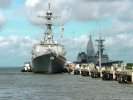 |  | 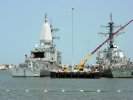 |  |
The photos below were taken by Thomas Zera on May 28, 2006, and show the decommissioned ARTHUR W. RADFORD at the Philadelphia Naval Shipyard.
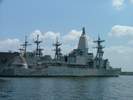 | 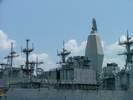 | 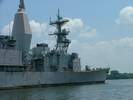 |
The photos below were taken by Brian Barton on May 22, 2007, and show the ARTHUR W. RADFORD at the Philadelphia Naval Shipyard. At that time she was stripped of her equipment.
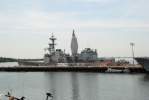 | 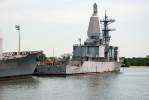 |
The photo below was taken by Brian Barton on October 13, 2008, and shows the ARTHUR W. RADFORD at the Philadelphia Naval Shipyard. The experimental mast has now been removed.
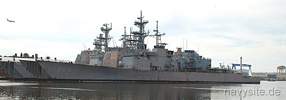 |
The photos below were taken by me on November 7, 2008, and show the ARTHUR W. RADFORD laid up at the Philadelphia Naval Shipyard.
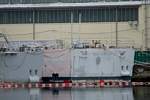 | 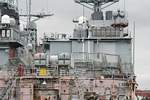 | 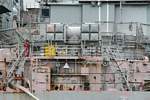 | Click here for more photos. | |
The photos below were taken by Thomas Zera on August 1, 2010, and show the ARTHUR W. RADFORD being prepared for sinking at the Philadelphia Naval Shipyard. Her masts are completely removed now and large holes have been cut into the forward superstructure.
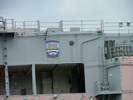 | 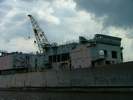 | 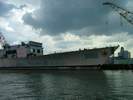 | Click here for more photos. | |
The photos below were taken by me on October 26, 2010, and show the ARTHUR W. RADFORD being prepared for sinking at the Philadelphia Naval Shipyard. Her masts are completely removed now and large holes have been cut into the forward superstructure.
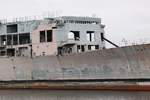 | 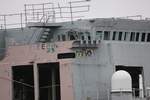 | 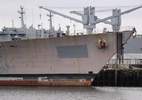 | Click here to view more photos. | |
 Back to Destroyers list.
Back to Destroyers list.  Back to ships list.
Back to ships list.  Back to selection page.
Back to selection page.  Back to 1st page.
Back to 1st page.